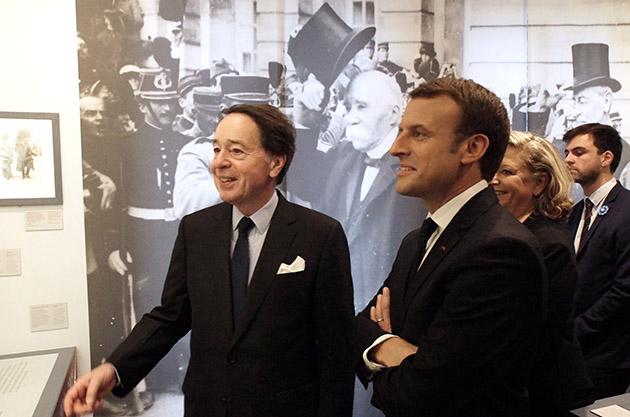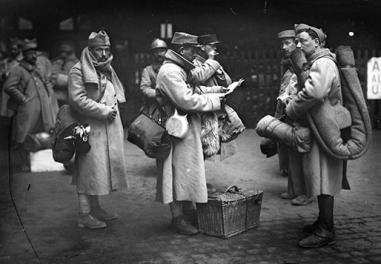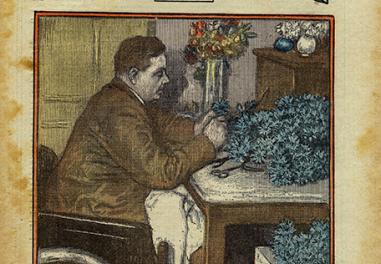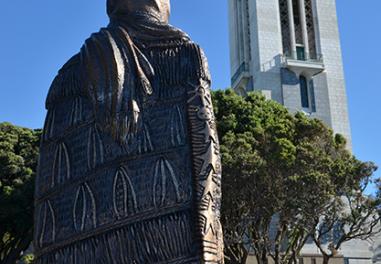2018: the Year of Clemenceau
Last 11 November, the French president paid tribute to Georges Clemenceau while visiting the former prime minister’s Parisian apartment that is now a museum. The perfect occasion to declare that 2018 would be the “Year of Clemenceau”.

In Paris, at the Champs-Élysées roundabout, the statues of France’s two war leaders sit one across from the other. At the metro exit stands the imposing statue of General de Gaulle, while on the other side of the avenue, the statue of Georges Clemenceau rises tall. Erected in 1932, it features the Father of Victory in mid-stride wearing a heavy coat and gaiters, his scarf blowing in the wind, as he was seen when visiting the poilus, a term of endearment (literally ‘the hairy ones’) for the French infantrymen in the war. Today, this image is without a doubt the most enduring in the memory of French citizens.
In 2018, it will be revived following the French President’s decision to pay homage, as one strand of the commemoration of the centenary of the First World War, to the victor Georges Clemenceau, the founder of the Third Republic who, appointed President of the Council by Poincaré in November 1917, pledged to "conquer or die". Despite the validity of his choice, it would be reductive to remember Clemenceau for nothing but his warrior image and to sum up his career as one led exclusively by an aggressive and warmongering strategy.
“WE WANT PEACE”
In 1917, Georges Clemenceau and his government declared themselves present to “work”, to work for a “war of salvation” and strive for peace. Consequently, on 20 November 1917, in his ministerial declaration to the Chamber of Deputies, the Tiger, as he was also known, pledged to lead “an integral war” prompted by his desire to bring an end to the deadly conflict as soon as possible: “We want peace; we would sacrifice everything to obtain it in the conditions of justice and beauty that are the worthy values of our country.” There are several explanations why Clemenceau was so fiercely committed to ending the war. First and foremost was his visceral aversion to extreme violence, a revulsion largely fuelled by his visits to the front from September 1915 in his capacity as President of the Senate Army Commission.
Indeed, his first visit, in Champagne, was not only for institutional purposes. From Suippes to Souain, his tour gave him the chance to meet these men “in the trenches who are moreover in a pitiful state as a consequence of the accumulation of mud and debris of all sorts, [these] men who display the most tranquil courage”, as he expressed before the Senate Army Commission on 30 September 1915.
This initial contact with the field was also an occasion to feel closer to his beloved younger brother Albert for whom he was extremely worried and regretful that he was unable to take his place on the battlefield. Not to mention that this initial visit, the first of many, etched forever in his mind the memory of Sergeant Poissonnier who “has other things to do than keep us in his memory, as anxious for his future as he is” but who “he [Clemenceau] will never forget”. This was how he described Sergeant Poissonnier in the French daily L’Homme enchaîné on 6 October 1915. The admiration and sincere affection the President of the Council felt for the troops was the constant driving force of his commitment to achieving peace. Once very much shocked by a visit to the "smoking ruins" of 1870 in the company of his friend Scheurer-Kestner, he was profoundly convinced of the urgent need to stop the war as swiftly as possible if it could not be avoided all together. This horror of bloodshed came from experience and philosophy on the existence of the “great man".
A FLAMBOYANT AND COMPLEX PERSONALITY
To proclaim 2018 as the Year of Clemenceau is not merely an opportunity to pay tribute to the intelligence and energy of a man of state but also to delve deeper into this flamboyant, complex and multi-faceted personality. To celebrate the ‘Father of Victory’ is to follow an infinite number of paths depending on one’s particular interests, desires and whim.
Born in Vendée, sent up to the capital to finish his studies in medicine, imprisoned in 1870 in a besieged Paris, mayor of his commune, doctor to the poor in Montmartre, member of parliament, senator, Dreyfusard, writer, friend to artists such as Monet, minister of the interior and later President of the Council and keen traveller, Georges Clemenceau was a constant champion of action and ideals. Elusive and contradictory, he was not always an easy man to fathom. This is why the Centenary Mission, the ministries of culture and the army (the Heritage, Remembrance and Archives Department) and sites of remembrance chose the year 2018 to organise or support a series of events.
CLEMENCEAU SEASON
Since January 2018, a capsule website has posted a detailed calendar of 1918, documents and articles, a rich collection of images, and coverage of the initiatives started by the French Presidential office. Several archive documents stored at the defence department’s history section and assembled by General Mordacq, the head of Clemenceau’s war cabinet, are currently being digitised. A total of 10,000 individual records.
In Paris, the Musée Clemenceau will be opening its doors to the public. In a gallery refurbished with funding from the French Army Ministry’s Heritage, Remembrance and Archives Department, visitors will get to see not only the different faces and numerous combats of the “warrior republican” but also the vast culture and tenderness of this private man in his apartment which is in the same condition as when he died on 24 November 1929. Exhibitions and guided tours will be organised through the year.
In Mouilleron-en-Pareds, the house of his birth has been turned into a national museum. A highlight in Vendée’s cultural calendar, its official inauguration took place in June 2018. A house and museum, it “has preserved all the emotion of a place of remembrance and will present the career of this man of ideas who made such an impression on the history of France through his mind and action” as head curator Marie-Hélène Joly likes to describe him. A few kilometres from there, in Saint-Vincent-sur-Jard, "La Bicoque", Clemenceau’s cherished retirement home, will also honour, through talks and other events, the host who entertained at his table a great many friends and who, in the silence and solitude of the night, used to write literature and love letters looking out at sea.
All of this will help us better understand the meaning of the oath to Clemenceau addressed by General de Gaulle on the BBC on 11 November 1941. Indeed, when the general uttered the unforgettable words: “From the depth of your Vendéen tomb, today 11 November, Clemenceau, you do not sleep!”, the war chief, as he was then, knew that the “old Tiger” could still inspire France for the immediate victory and the century to come. An exhibition at the Pantheon in November 2018 will show how true this was.
Read more
Bibliography
Clemenceau, Sylvie Brodziak, Presses universitaires de Vincennes, 2015.
Clemenceau au front, Samuël Tomei, éditions Pierre de Taillac/ministère de la Défense, 2015.
Dictionnaire Clemenceau, Sylvie Brodziak et Samuel Tomei (dir.), préface de Jean-Noël Jeanneney, collection Bouquins, Robert Laffont, 2017.
Remebrance sites
Articles of the review
-
The file

1918, exiting from the war
The Armistice of 11 November 1918 was the catalyst for a complex period during which the withdrawal of four million soldiers was enacted. The first phase consisted of demobilising the troops, in other words organise their repatriation home. For many, above all soldiers sent from the colonies, demobi...Read more -
The figure

To Bleuets, citizens!
The centenary of the year 1918 will give many the occasion to don the “Bleuet de France” which came about in the wake of the First World War. A symbol of remembrance and solidarity, the bleuet or cornflower still fulfils the same vocation today and provides moral support for the injured an...Read more -
The interview

Bridget Gee
Bridget Gee is head of external relations at the New Zealand embassy in Paris. In her role, she is in charge of planning Franco-New-Zealand commemorations, especially the 2018 inauguration of the French monument in Wellington.
Read more

